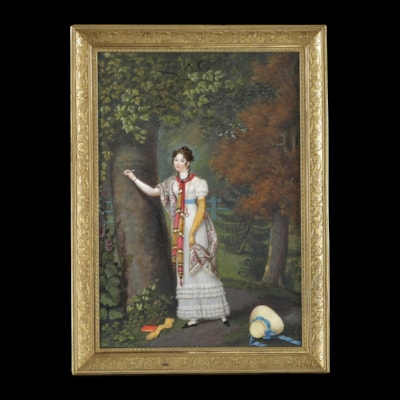NUNES DE CARVALHO
(fl. early 19th-century)Portrait miniature of Sir John Downie (1777-1826), with a patch on his right cheek, wearing the Order of Charles III; c. 1813
Circa 1813
Oval, 6.5 cm (2 ¹/₂ inches)
Watercolour on ivory
Ivory registration number: AEFXUDKQ
Gilt metal frame
SOLD
It soon became clear that Downie was gaining a large amount of local support. The British army had been posted in Spain to defend against Napoleon, who had gained control of the country and taken their leader, Ferdinand VII, captive. One particular source labelled him as having ‘a dash of Don Quixotism in his valour.[3]’. In 1810, he formally joined the Spanish Army. This gave Downie a particular power in having support and influence in both Britain and Spain. With this support, he formed the Legión Extremeña, with uniforms and weapons, including the sword that had been used by Francisco Pizzaro, the Spanish Conquistador. The legion fought numerous battles and skirmishes over the next few years. In 1812, they were involved in an attack on French-controlled Seville. During the charge, Downie was hit by a grapeshot on his right cheek, leaving a severe wound, hitting his ear also, and causing him to lose sight in his right eye. Not only did he suffer these injuries, but he was also captured and kept as a prisoner by French forces.
It is from this story of battle that the distinctive patch featured in this portrait originates. The majority of known depictions of Downie have some reference to the injury that he sustained, and this is something that he would have been happy to show to others as a mark of his courage. Depictions from as early as the 1680s[4] are intended to emphasise the presence of patches on gentlemen’s faces. Historically, these patches also had numerous medicinal purposes, including curing migraines.
Only a few other works by Nunes de Carvalho, also only known through engravings, exist, all of which are of military figures. The Portuguese origin of the artist could also have links with Downie’s previous position as Acting Assistant Commissary in Portugal. This allows us to date the miniature to circa 1812/13, painted before he returned to Scotland, where he was praised as a war hero. It would have been on this trip that the miniature made its way into the collection of James Duff, who had also fought in Spain. Duff was a keen patron of the arts, and his collection contained a large number of works by Spanish artists.
We are grateful to Stephen Wood for his assistance in identifying this sitter's uniform.
[2] Downie’s Biography was featured in the issue published in July 1813.
[3] Quoted in ‘The Extraordinary Life of Sir John Downie’, Rob Griffith, published 18 August 2019, https://daringdutycunningplans.wordpress.com/2019/08/18/the-extraordinary-life-of-sir-john-downie/, accessed 10 July 2025.
[4] See the Plumbago portrait of Peter Mews, by David Loggan, c.1684, at the National Portrait Gallery, collection no. NPG1872.
Private collection.

shipping notice
Worldwide shipping is included in all prices.
The Limner Company does not accept any responsibility for import duty, this is to be paid by the buyer.
Some stock items contain materials from endangered species which are governed by CITES regulations and will require a permit to export outside of Great Britain. If a certificate of export is required then this will be the responsibility of and paid for by the buyer .
you may also like













